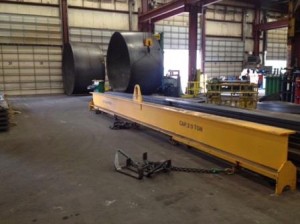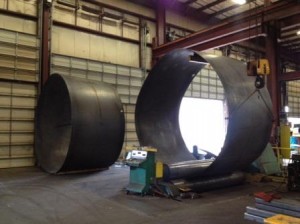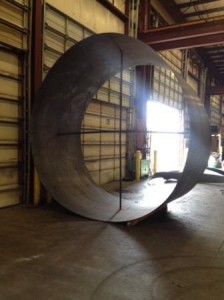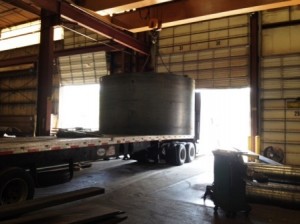The construction of steel tanks for the storage of hazardous materials must be done carefully. The tanks’ seams are often considered to be a potential point of failure. For structural reasons, therefore, tank construction with as few seams as possible is desired, and, when possible, single seam construction is preferred. But this single-seam requirement can be a daunting task for the people involved in their production because handling and transporting the materials to make these tanks requires a certain level of experience, expertise and special equipment.
The design diameter of these tanks is somewhat restricted by maximum shippable lengths of the materials used in their construction.
If a plate processor who slits and levels the steel can also roll the material into a tank, it can eliminate the transportation of the raw material. If the flat blanks need to be shipped to a company to roll the steel, the maximum shippable length is 70ft loaded on a flatbed “stretch” trailer. Consequently, it is unusual to see single-seam tanks in diameters over 22ft.
Furthermore, coils come in a maximum width of 97.5in which further restricts the design dimensions of the tank. And after slitting, the maximum tank height will become slightly less than 97.5in. Most plate processing companies who level coil can do so at a maximum thickness of ½in, but when referring to these thin-wall tanks, we will only consider steel in 3/16in – ¼in thick.
After materials are slit from coil and ready for shipment, one needs to load and unload the flatbed trailer that will be shipping the steel. In order to handle these very long, thin, cumbersome plates, special, below-the-hook handling equipment is necessary to complete the lifts, e.g. spreader beams, plate hooks, magnets, or vacuum suction cups.

To the inexperienced, this handling may seem like no big deal, but the extreme flexibility of the plates makes them extremely hard to handle even at lengths of only 20ft.
Another worry when loading and unloading the materials for these tanks is not to damage the plates. Plastic deformation or stretching of the material can occur and result in a kink in the plate.
And then rolling of these plates requires a well-thought-out process as shipping anything over 14-15ft in diameter can become expensive and difficult.
So how do you roll steel plate for tanks with diameters up to 22ft when you can only ship rolled plate cylinders up to 14-15ft in diameter? In order to successfully complete a rolling job like this, the ends of the plates must overlap one another until the rolled plate’s diameter is within shippable dimensions. At this point the overlapping plates are tack welded into place.

The extreme flexibility of these plates, which once caused a headache on the material handling side, now plays a significant role in how they are erected. Once in the field the tack welds are broken, and the rolled plate is opened up through the assistance of a crane to their designed diameter.
If the plates were not so flexible, adjusting their diameter this way would not be possible. Also, if the entire length of the plate was rolled to the shippable diameter, when the rolled plates are opened in the field at time of erection, the ends of the plate would not meet as designed at the tank’s seam. Rather, they would curve in further towards the tanks ID, making the tank a sort of heart-shaped geometry (If you try to visualize this, the seam would look somewhat like the number 3.).
In order to avoid this happening, each end of the plate, the portion that gets overlapped on one another, gets rolled to the tank’s true design diameter, and the rest of the plate is rolled to the shippable diameter. The rolled plate is not truly round but somewhat egg shaped/multi-radial. The rolled plate cylinders are then braced properly, loaded onto the trailer just as carefully as the straight long plates were unloaded, paired with an escort and shipped via wide load to their destination.









